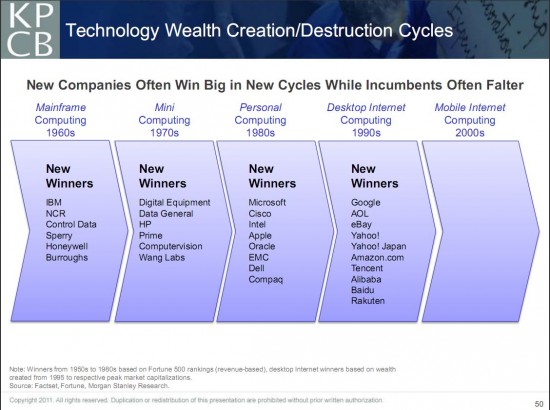To believe some of the worrywarts around Washington, we find ourselves in the midst of a miserable mobile marketplace experience. Regulatory advocates like New America Foundation, Free Press, Public Knowledge and others routinely claim that the sky is falling on consumers and that far-reaching regulation of the wireless sector is needed to save the day.
I hope those folks are still willing to listen to facts, becuase those facts tell a very different story. Specifically, I invite critics to flip through the latest presentation by Internet market watchers Mary Meeker and Matt Murphy of Kleiner Perkins Caufield & Byers on “Top Mobile Internet Trends” and then explain to me how we can label this marketplace anything other than what it really is: One of the greatest capitalist success stories of modern times. Just about every metric illustrates the explosive growth of technological innovation in the U.S. mobile arena. I’ve embedded the entire slideshow down below, but two particular slides deserve to be showcased.
The first slide illustrates “Computing Growth Drivers Over Time” from the 1960s to present and shows how roughly 10 Billion mobile Internet devices will soon be upon upon us. TEN BILLION!! As the subtitle of the slide summarizes: “Reduced Usage Friction via Better Processing Power + Improved User Interface + Smaller Form Factor + Lower Prices + Expanding Services = 10xMore Devices.” Again, absolutely amazing innovation is occuring in all layers of this space.
But wait, shouldn’t we fear that the same old big, bad corporate behemoths will dominate the mobile Internet marketplace? The second slide down below explains why such pessimism is unwarranted. True, every generation has its share of large operators in each sector, but Meeker and Murphy’s depiction of “Technology Wealth Creation / Destruction Cycles” over time illustrates why high-tech markets are far more dynamic than critics suggest.
As the subtitle of that slide notes, “New Companies Often Win Big in New Cycles While Incumbents Often Falter.” Today’s titans often become tomorrow’s technological also-rans. For example, who in the 1970s would have thought that anyone could give IBM a serious run for its money? And yet IBM ended up completely missing the boat on the rise of home personal computing as the company was myopically stuck in a mainframe mindset that made it serious money in the past but crippled the company for the future. (See this post for more details on the dramatic decline of Big Blue.) Ditto for AOL in the late 1990s or early 2000s. As I’ve documented here before, AOL was considered the unassailable giant of the Internet space during that period. Today, many of us struggle to figure out how the company even still exists! In other words, today’s mobile marketplace giants won’t likely be tomorrow’s. New forces and faces will move in that we can not yet fathom.
Bottom line: Don’t let the cyber-Chicken Littles and tech worrywarts fool you. Things are getting better all the time!



 The Technology Liberation Front is the tech policy blog dedicated to keeping politicians' hands off the 'net and everything else related to technology.
The Technology Liberation Front is the tech policy blog dedicated to keeping politicians' hands off the 'net and everything else related to technology.